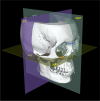Three-dimensional assessment of facial asymmetry in Class III subjects. Part 1: a retrospective study evaluating postsurgical outcomes
- PMID: 35320382
- PMCID: PMC9276556
- DOI: 10.1007/s00784-022-04463-4
Three-dimensional assessment of facial asymmetry in Class III subjects. Part 1: a retrospective study evaluating postsurgical outcomes
Abstract
Objective: The present study aimed to determine the site and severity of maxillomandibular asymmetry before and after orthognathic surgery in asymmetric patients.
Materials and methods: Presurgery and postsurgery cone beam computed tomography (CBCT) data of 21 facial asymmetry patients (7 males and 14 females, mean age: 23.0 ± 3.36 years) with soft tissue chin deviation ≥ 3 mm who had undergone bimaxillary surgery were evaluated. Seven midline and twenty bilateral hard tissue landmarks were identified for the evaluation of facial asymmetry and outcomes were assessed against age- and gender-matched control subjects.
Results: In the asymmetry group, bilateral landmarks exhibited significant deviation in the mandible and midface regions. Before surgery, asymmetry was more severe at the mandibular midline and sites close to it, in the asymmetry group. Bimaxillary surgery proved to be highly effective, with a significant correction of the menton to a clinically normal value (2.90 mm, p < 0.001). After surgery, significant residual asymmetry was observed at the mental foramen (p = 0.001) in the R-L direction. Moreover, significant asymmetry persisted at the sigmoid notch (p = 0.001) in the S-I direction.
Conclusions: Mandibular midline landmarks and chin peripheral regions contribute significantly to overall facial asymmetry characteristics. Despite significant correction after bimaxillary surgery, asymmetry persisted at several sites, thereby requiring secondary correction. Comprehensive 3D presurgical planning is central for asymmetry correction in a single surgery.
Clinical relevance: The present study specifies the location of residual asymmetry sites and advocates the correction of those sites during initial surgery.
Keywords: Facial asymmetry; Maxillomandibular asymmetry 3D; Orthognathic surgery; Three-dimensional.
© 2022. The Author(s).
Conflict of interest statement
The authors declare no competing interests.
Figures



Similar articles
-
Site and severity of facial asymmetry after bimaxillary surgery for class III deformity: a case-control study.Clin Oral Investig. 2024 May 23;28(6):334. doi: 10.1007/s00784-024-05729-9. Clin Oral Investig. 2024. PMID: 38780816
-
Type of mandibular asymmetry affects changes and outcomes of bimaxillary surgery for class III asymmetry.Clin Oral Investig. 2022 Jan;26(1):1077-1088. doi: 10.1007/s00784-021-04092-3. Epub 2021 Aug 2. Clin Oral Investig. 2022. PMID: 34338893
-
Improved lip esthetics in patients with skeletal Class III malocclusion and facial asymmetry after isolated mandibular orthognathic surgery.Am J Orthod Dentofacial Orthop. 2022 May;161(5):e407-e415. doi: 10.1016/j.ajodo.2021.12.010. Epub 2022 Jan 5. Am J Orthod Dentofacial Orthop. 2022. PMID: 34996662
-
Prevalence of mandibular asymmetry in different skeletal sagittal patterns.Angle Orthod. 2022 Jan 1;92(1):118-126. doi: 10.2319/040921-292.1. Angle Orthod. 2022. PMID: 34546287 Free PMC article.
-
[Quantification of Facial Asymmetry : A Comprehensive Review of Methods and Applications].Orthod Fr. 2025 Jan 22;95(4):347-353. doi: 10.1684/orthodfr.2024.170. Orthod Fr. 2025. PMID: 39840736 Review. French.
Cited by
-
Predicting Optimal Patient-Specific Postoperative Facial Landmarks for Patients with Craniomaxillofacial Deformities.medRxiv [Preprint]. 2023 Dec 14:2023.12.13.23299919. doi: 10.1101/2023.12.13.23299919. medRxiv. 2023. Update in: Int J Oral Maxillofac Surg. 2024 Nov;53(11):934-941. doi: 10.1016/j.ijom.2024.05.004. PMID: 38187692 Free PMC article. Updated. Preprint.
-
Comparison of Mirroring and Overlapping Analysis and Three-Dimensional Soft Tissue Spatial Angle Wireframe Template in Evaluating Facial Asymmetry.Bioengineering (Basel). 2025 Jan 16;12(1):79. doi: 10.3390/bioengineering12010079. Bioengineering (Basel). 2025. PMID: 39851353 Free PMC article.
-
3-dimensional analysis of hard- and soft-tissue symmetry in a Chinese population.BMC Oral Health. 2023 Jun 29;23(1):432. doi: 10.1186/s12903-023-03163-z. BMC Oral Health. 2023. PMID: 37386472 Free PMC article.
-
Site and severity of facial asymmetry after bimaxillary surgery for class III deformity: a case-control study.Clin Oral Investig. 2024 May 23;28(6):334. doi: 10.1007/s00784-024-05729-9. Clin Oral Investig. 2024. PMID: 38780816
-
Determining post-orthognathic surgery profile: A validation study on the potential of modified chin point as a reliable predictor.PLoS One. 2025 Aug 22;20(8):e0329535. doi: 10.1371/journal.pone.0329535. eCollection 2025. PLoS One. 2025. PMID: 40845022 Free PMC article.
References
MeSH terms
LinkOut - more resources
Full Text Sources

